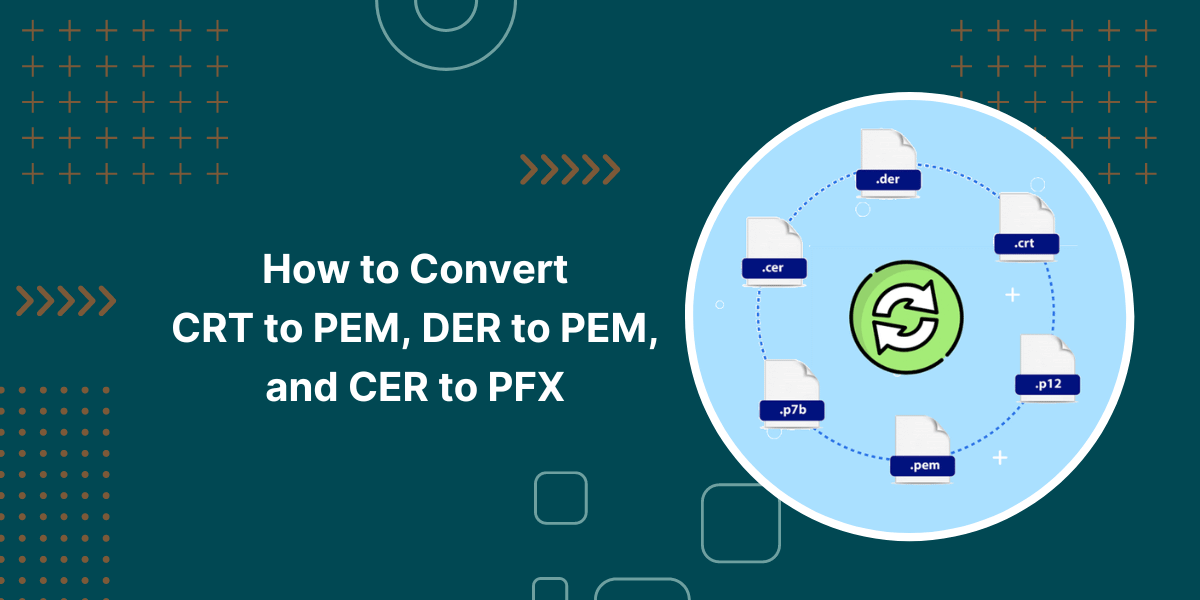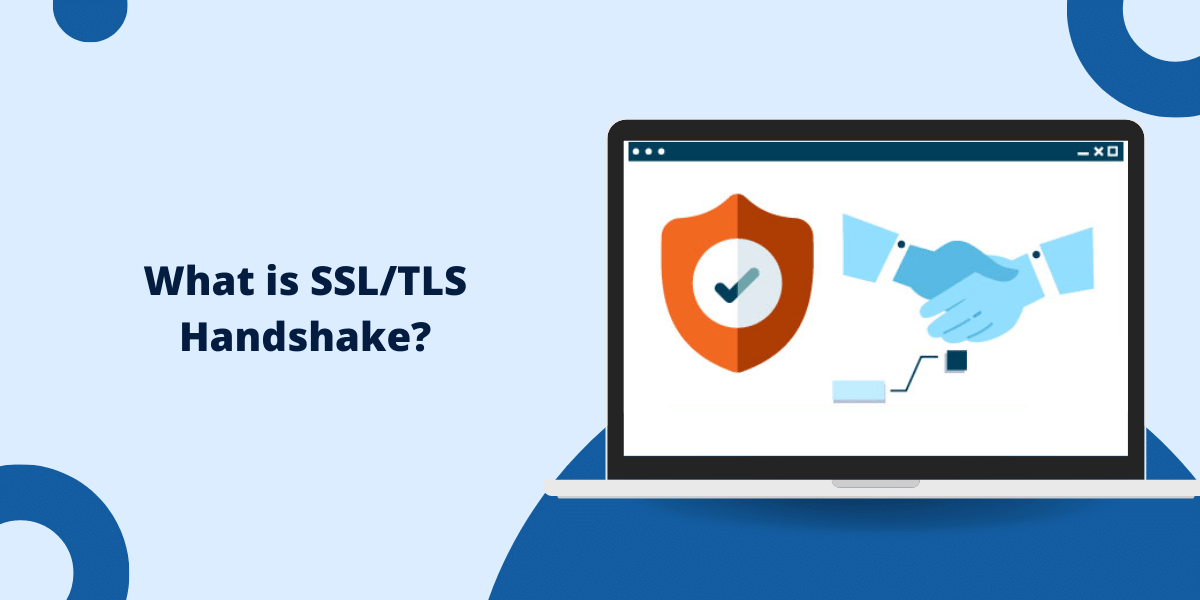Step-by-Step Guide on How to Convert Your SSL from CER to PEM, CRT to PEM, DER to PEM, and CER to PFX Format
Certificates come in different formats, and it’s essential to understand these formats and how to convert between them. This article will explore the PEM, DER, CRT, CER, and PKCS#12 certificate formats, their differences, and the steps to convert between them. The most common formats are PEM (Privacy Enhanced Mail), DER (Distinguished Encoding Rules), CRT (Certificate), CER (Certificate), and PKCS#12 (Personal Information Exchange Syntax Standard).
Understanding these different SSL file formats and their conversions is essential for system administrators, developers, and anyone working with secure communication protocols. Whether you’re setting up SSL/TLS connections, managing certificate authorities, or dealing with encryption and decryption tasks, the ability to convert between certificate formats is a valuable skill.
Key Takeaways
- PEM is a text-based encoding format for certificates and keys, making it human-readable and easy to edit.
- DER is a binary encoding format for certificates and keys, resulting in smaller file sizes but less human-readable.
- CER and CRT are common file extensions used for certificates, often interchangeable with PEM and DER formats.
- PKCS#12 is a container format that can store certificates, private keys, and additional information in a single file.
- OpenSSL is a widely used command-line tool for converting between various certificate formats.
PEM (Privacy Enhanced Mail) Format
Overview of PEM Format
ASCII Text-Based Encoding for X.509 Certificates and Keys
The PEM format, also known as Privacy Enhanced Mail, is a text-based encoding format used for storing and transmitting X.509 certificates and cryptographic keys. It uses ASCII text, making it human-readable and easy to edit with any text editor. PEM files are typically used for SSL/TLS certificates, public keys, private keys, and certificate bundles (chains).
Supports storage of certificates, private keys, and certificate chains
One of the advantages of the PEM format is its flexibility in storing different types of data. It can contain X.509 certificates, private keys, and even certificate chains (a bundle of multiple certificates). This makes PEM files suitable for various applications, such as web servers, email clients, and code signing.
PEM File Extensions
.crt, .pem, .cer, .key (for private keys)
PEM files can have different extensions, depending on their content and intended use. The most common extensions are:
- .crt or .pem: Used for X.509 certificates.
- .cer: Also used for X.509 certificates, sometimes interchangeable with .crt or .pem.
- .key: Used for private keys associated with certificates.
Can also use .ca-bundle for CA certificate bundles
When dealing with certificate chains or bundles, the .ca-bundle extension is often used to denote a file containing multiple Certificate Authority (CA) certificates concatenated together.
Viewing PEM certificates
Structure of PEM certificates (headers, base64 data, footers)
A PEM file has a specific structure that consists of headers, base64-encoded data, and footers. The headers and footers are plain text markers that indicate the type of data contained in the file. For example, a PEM-encoded certificate would have the following structure:
-----BEGIN CERTIFICATE-----
(Base64-encoded certificate data)
-----END CERTIFICATE-----
The base64-encoded data between the headers and footers represents the actual certificate or key information.
Example of a PEM certificate
Here’s an example of a PEM-encoded X.509 certificate:
In this example, the certificate data is enclosed between the —–BEGIN CERTIFICATE—– and —–END CERTIFICATE—– markers.
-----BEGIN CERTIFICATE-----
MIIEBDCCAuygAwIBAgIDAjppMA0GCSqGSIb3DQEBBQUAMEIxCzAJBgNVBAYTAlVT
MRYwFAYDVQQKEw1HZW9UcnVzdCBJbmMuMRswGQYDVQQDExJHZW9UcnVzdCBHbG9i
YWwgQ0EwHhcNMTMwNDA1MTUxNTU1WhcNMTUwNDA0MTUxNTU1WjBJMQswCQYDVQQG
EwJVUzETMBEGA1UEChMKR29vZ2xlIEluYzElMCMGA1UEAxMcR29vZ2xlIEludGVy
bmV0IEF1dGhvcml0eSBHMjCCASIwDQYJKoZIhvcNAQEBBQADggEPADCCAQoCggEB
AJwqBHdc2FCROgajguDYUEi8iT/xGXAaiEZ+4I/F8YnOIe5a/mENtzJEiaB0C1NP
VaTOgmKV7utZX8bhBYASxF6UP7xbSDj0U/ck5vuR6RXEz/RTDfRK/J9U3n2+oGAv
...
(Base64-encoded data continues)
...
ezt0Ty6dNNCXnSSRtxGbTcNmWmOZr88n
-----END CERTIFICATE-----
Common PEM conversions
View contents of PEM certificate
To view the contents of a PEM-encoded certificate, you can use a text editor or the openssl command-line tool. For example, to view the details of a certificate named example.crt, you can run:
openssl x509 -in example.crt -text -noout
This command will display the certificate information, such as the subject, issuer, validity period, and other details.
Convert PEM certificate to DER format
To convert a PEM-encoded certificate to the binary DER format, you can use the openssl command:
openssl x509 -in example.crt -outform der -out example.der
This command will create a new file example.der containing the DER-encoded version of the certificate.
Convert PEM certificate with chain to PKCS#7 format
If you have a PEM-encoded certificate along with a certificate chain (intermediate and root CA certificates), you can convert them to the PKCS#7 format using the following command:
openssl crl2pkcs7 -certfile example.crt -certfile intermediate.crt -certfile root.crt -outform der -out example.p7b
Replace example.crt, intermediate.crt, and root.crt with the appropriate file names for your certificate and chain.
Convert PEM certificate with chain and private key to PKCS#12 format
To convert a PEM-encoded certificate, certificate chain, and private key to the PKCS#12 format, you can use the following command:
openssl pkcs12 -export -out example.pfx -inkey example.key -in example.crt -certfile intermediate.crt -certfile root.crt
DER (Distinguished Encoding Rules) Format
Overview of DER format
Binary encoding for X.509 certificates and keys
The DER (Distinguished Encoding Rules) format is a binary encoding method used for representing X.509 certificates and cryptographic keys. Unlike the PEM format, which is text-based, DER uses a compact binary representation, resulting in smaller file sizes.
Smaller file size compared to PEM
One of the primary advantages of the DER format is its compact size. Since it’s a binary encoding, DER files are generally smaller than their PEM counterparts, which can be beneficial in situations where file size is a concern, such as embedded systems or resource-constrained environments.
DER File Extensions
.der, .cer
The most common file extensions used for DER-encoded certificates and keys are:
- .der: Used for X.509 certificates and keys in DER format.
- .cer: Also used for X.509 certificates in DER format, sometimes interchangeable with .der.
It’s worth noting that while the .cer extension is often associated with the DER format, it can also be used for PEM-encoded certificates, leading to potential confusion.
Viewing DER-encoded certificates
Structure of DER Certificates (Binary Data)
Unlike PEM files, which are human-readable text, DER certificates consist of binary data. This means that you cannot view the contents of a DER certificate directly in a text editor. Instead, you need to use specialized tools or commands to decode and display the certificate information.
Common DER Conversions
View Contents of DER-encoded Certificate
To view the contents of a DER-encoded certificate, you can use the openssl command-line tool. For example, to view the details of a certificate named example.der, you can run:
openssl x509 -in example.der -text -noout
This command will decode the binary DER data and display the certificate information in a human-readable format.
Convert DER-encoded certificate to PEM format
To convert a DER-encoded certificate to the PEM format, you can use the following OpenSSL command:
openssl x509 -in example.der -inform der -outform pem -out example.pem
This command will create a new file example.pem containing the PEM-encoded version of the certificate.
Convert DER-encoded certificate with chain and private key to PKCS#12 format
If you have a DER-encoded certificate along with a certificate chain and private key, you can convert them to the PKCS#12 format using the following command:
openssl pkcs12 -export -out example.pfx -inkey example.key -in example.der -certfile intermediate.der -certfile root.der
Replace example.der, intermediate.der, root.der, and example.key with the appropriate file names for your certificate, chain, and private key.
Other X.509 Certificate Formats
CRT (Certificate) Format
Interchangeable with .cer Extension
The CRT (Certificate) format is often used interchangeably with the .cer extension. Both extensions can represent X.509 certificates encoded in either PEM or DER format.
Conversion to PEM format
If you have a CRT file and need to convert it to the PEM format, you can use the openssl command:
openssl x509 -in example.crt -inform der -outform pem -out example.pem
This command assumes that the example.crt file is in DER format. If it’s already in PEM format, you can omit the -inform der option.
CER (Certificate) format
Interchangeable with .crt extension
Similar to the CRT format, the CER (Certificate) format is also often used interchangeably with the .crt extension. Both extensions can represent X.509 certificates encoded in either PEM or DER format.
Conversion to PEM and PKCS#12 formats
If you have a CER file and need to convert it to the PEM format, you can use the same command as for CRT files:
openssl x509 -in example.cer -inform der -outform pem -out example.pem
To convert a CER file to the PKCS#12 format, along with a private key and certificate chain, you can use the following command:
openssl pkcs12 -export -out example.pfx -inkey example.key -in example.cer -certfile intermediate.cer -certfile root.cer
Replace example.cer, intermediate.cer, root.cer, and example.key with the appropriate file names for your certificate, chain, and private key.
PKCS#7 Format
Container format for certificates and CRLs
The PKCS#7 (Public Key Cryptography Standards #7) format is a container format used to store and transmit digital certificates, certificate revocation lists (CRLs), and other related data. It is commonly used to exchange certificates and CRLs between different systems or applications.
Conversion from PEM certificates
To convert a PEM-encoded certificate, or a certificate chain, to the PKCS#7 format, you can use the openssl command:
openssl crl2pkcs7 -certfile example.crt -certfile intermediate.crt -certfile root.crt -outform der -out example.p7b
Replace example.crt, intermediate.crt, and root.crt with the appropriate file names for your certificate and chain.
PKCS#12 Format
Container format for certificates and private keys
The PKCS#12 (Personal Information Exchange Syntax Standard #12) format is a widely used container format for storing and exchanging certificates, private keys, and other related data. It provides a secure way to bundle multiple certificates, keys, and additional information into a single file, often protected by a password.
Conversion from PEM certificates with private keys
To convert a PEM-encoded certificate, certificate chain, and private key to the PKCS#12 format, you can use the following command:
openssl pkcs12 -export -out example.pfx -inkey example.key -in example.crt -certfile intermediate.crt -certfile root.crt
Replace example.pfx, example.key, example.crt, intermediate.crt, and root.crt with the appropriate file names for your certificate, private key, and certificate chain.
OpenSSL Commands for Certificate Conversions
Throughout this article, we’ve used the openssl command-line tool for various certificate conversions. OpenSSL is a widely used open-source toolkit that provides a comprehensive set of cryptographic functions and utilities, including the ability to work with certificates and keys in different formats.
Here’s the most common OpenSSL commands used for converting between the various certificate formats:
Converting CRT to PEM
openssl x509 -in example.crt -inform der -outform pem -out example.pem
Converting DER to PEM
openssl x509 -in example.der -inform der -outform pem -out example.pem
Converting CER to PEM
openssl x509 -in example.cer -inform der -outform pem -out example.pem
Converting CER to PKCS#12
openssl pkcs12 -export -out example.pfx -inkey example.key -in example.cer -certfile intermediate.cer -certfile root.cer
Note that when converting to PKCS#12 format, you need to provide the certificate file (e.g., example.cer), the private key file (e.g., example.key), and any intermediate and root CA certificates necessary for the certificate chain.
Importance of Certificate Formats
Compatibility with Various Applications and Systems
Different applications and systems may have specific requirements or preferences for the certificate format they can handle. For example, some web servers may expect certificates in PEM format, while others may require DER or PKCS#12. Understanding and being able to convert between different certificate formats ensures compatibility and seamless integration with a wide range of systems and applications.
Secure Storage and Transmission of Certificates
Certain certificate formats, such as PKCS#12, are designed for secure storage and transmission of certificates and private keys. By bundling multiple components (certificates, keys, and additional data) into a single file, PKCS#12 provides a convenient and secure way to manage and distribute sensitive cryptographic information.
Choosing the Right Format for Specific Use Cases
Each certificate format has its strengths and use cases. For instance, the PEM format is human-readable and easy to edit, making it suitable for manual inspection or configuration. DER, on the other hand, is compact and efficient for embedded systems or situations where file size is a concern. Understanding the characteristics of each format helps you choose the most appropriate one for your specific requirements.
Final Thoughts
Mastering the art of converting between different certificate formats is an invaluable skill for anyone working with secure communication protocols. Whether you’re dealing with web servers, email clients, or code signing, understanding the nuances of PEM, DER, CRT, CER, and PKCS#12 formats ensures seamless integration and compatibility across diverse systems and applications. With the power of OpenSSL and the knowledge gained from this guide, you can confidently navigate the world of certificate conversions, enabling secure data transmission and establishing trust in the digital realm. Embrace the flexibility of these formats and unlock the full potential of your security infrastructure.
FAQs
What is the difference between PEM and DER formats?
PEM (Privacy Enhanced Mail) is a text-based encoding format for X.509 certificates and cryptographic keys, whereas DER (Distinguished Encoding Rules) is a binary encoding format. PEM files are human-readable and typically larger, while DER files are more compact but not human-readable.
Can I convert a DER-encoded certificate to PKCS#12 format?
Yes, you can convert a DER-encoded certificate, along with the private key and certificate chain, to the PKCS#12 format using the openssl command-line tool. This allows you to bundle the certificate, private key, and additional data into a single file.
What is the purpose of the PKCS#7 format?
The PKCS#7 (Public Key Cryptography Standards #7) format is a container format used to store and transmit digital certificates, certificate revocation lists (CRLs), and other related data. It is commonly used to exchange certificates and CRLs between different systems or applications.
Can I convert a PKCS#12 file back to individual PEM or DER formats?
Yes, you can extract individual components (certificates, private keys, etc.) from a PKCS#12 file and convert them to PEM or DER formats using the openssl command-line tool.
What is the benefit of using the PKCS#12 format?
The PKCS#12 format provides a secure way to bundle multiple certificates, private keys, and additional information into a single file, often protected by a password. This makes it convenient for storing and distributing sensitive cryptographic data while ensuring its integrity and confidentiality.

Priya Mervana
 Verified Web Security Experts
Verified Web Security Experts
Priya Mervana is working at SSLInsights.com as a web security expert with over 10 years of experience writing about encryption, SSL certificates, and online privacy. She aims to make complex security topics easily understandable for everyday internet users.


